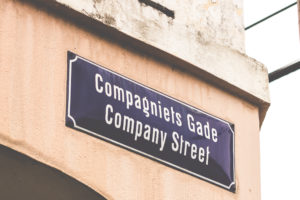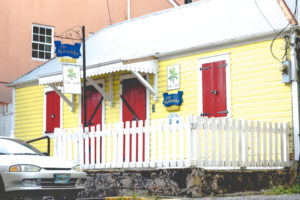History, Art, Culture of the U.S. Virgin Islands
About Company Street Chronicles – USVI
 Company Street. What’s in a name? In the parlance of the U. S. Virgin Islands, the word “Company,” can be used to express several different sentiments. For instance, if the phone rings and you want to keep the conversation short, you may tell your caller, “Call me laytah, ah gah company!” Or if you are sweating it out at a quadrille dance in St. Gerard’s Hall and Curtis Williams or Patsy Morris yells “Companeee!” you know they are calling for everyone to move together in the same direction. Or if you go to visit your grandmother who hasn’t seen you in a very long time, she may say, “Chile, ah glad to see you, glad you come to keep granny company!”Or if you are angry at a friend or relative that has disappointed you, you may remark “She’n no company ah mine!” Or if you notice that two people you know very well are spending a lot of time together, you may observe, “Eh-eh, me’n know dem two keeping company?!” However, none of these sentiments explain how Company Street, Christiansted, St. Croix got its name.
Company Street. What’s in a name? In the parlance of the U. S. Virgin Islands, the word “Company,” can be used to express several different sentiments. For instance, if the phone rings and you want to keep the conversation short, you may tell your caller, “Call me laytah, ah gah company!” Or if you are sweating it out at a quadrille dance in St. Gerard’s Hall and Curtis Williams or Patsy Morris yells “Companeee!” you know they are calling for everyone to move together in the same direction. Or if you go to visit your grandmother who hasn’t seen you in a very long time, she may say, “Chile, ah glad to see you, glad you come to keep granny company!”Or if you are angry at a friend or relative that has disappointed you, you may remark “She’n no company ah mine!” Or if you notice that two people you know very well are spending a lot of time together, you may observe, “Eh-eh, me’n know dem two keeping company?!” However, none of these sentiments explain how Company Street, Christiansted, St. Croix got its name.
In the U.S. Virgin Islands, formerly the Danish West Indies, street names are repeated in the towns of the three main islands. There are King Streets, Queen Streets, Prince Streets and Strand Streets to be found in Charlotte Amalie, St. Thomas, Christiansted and Frederiksted, St. Croix and Cruz Bay, St. John. On St. Thomas, their Danish versions, Kongens (King) Dronnigens (Queen/Main) and Prindsens (Prince) are more familiar. The street names of course, reflect the colonial politics at the time of their founding, as Charlotte Amalie was named for the Danish queen and therefore the Main Street of the town is Dronnigens Gade or Queen Street, while in the towns of Christiansted and Frederiksted, the main thoroughfares are named for the Danish kings Christian and Frederik. As far as I can tell, however, there is only one Company Street.
Historians believe that the second major street in the town of Christiansted, U.S. Virgin Islands is named for the Danish West India and Guinea Company, which was the financial structure by which the Danes funded their economic expansion into the Caribbean. According to St. Croix historian George F. Tyson, in his article “Getting It Straight: The Contributions of Africans to the Establishment of Christiansted,” “the Company”, was a “Copenhagen based joint-stock business venture, whose stockholders were the King of Denmark, members of the Danish nobility and royal administration.” (29-44) The Guinea part of the name of course referred to the West Coast of Africa from which they would get the labor to fuel their enterprise. “The Company” was chartered in 1671 and participated in the historic “triangle of trade” which included enslaving people from West Africa to work the raw materials from the Americas and the Caribbean to produce the manufactured goods of Europe. Tyson points out that “the Company” having already owned St. Thomas and St. John from 1671, purchased St. Croix in 1733 from the French and founded Christiansted in 1735. “The Company” lent its name to the second most important street in the town. St. Croix historian Arnold Highfield, in his article “An Overview of the History of Christiansted,” points out that because its stockholders believed it was too restrictive and not making enough money, “the Company” sold its interests to the Danish Crown in 1754 (5-28).
 The centuries-old buildings that line Company Street are two stories high with a masonry first floor and a wooden second floor. Highfield states that colonial era merchants warehoused or sold merchandise from the first floor while living on the second floor with their families. This pattern of use evolved as the economy of the island changed from sugar to tourism and oil and the flag that flew over the island changed from Danish to American. Stores that sold the materials necessary for maintaining sugar plantations in the 18th and 19thcenturies became the gift and jewelry stores of the 20th and 21st.
The centuries-old buildings that line Company Street are two stories high with a masonry first floor and a wooden second floor. Highfield states that colonial era merchants warehoused or sold merchandise from the first floor while living on the second floor with their families. This pattern of use evolved as the economy of the island changed from sugar to tourism and oil and the flag that flew over the island changed from Danish to American. Stores that sold the materials necessary for maintaining sugar plantations in the 18th and 19thcenturies became the gift and jewelry stores of the 20th and 21st.
St. Croix architect Gerville Larsen has established his business Taller Lajas, LLC at the 20A Queen Street first floor location where his maternal grandfather Alejandro Rojas was a Christiansted merchant for several decades. He has followed the centuries-old pattern and lives upstairs in the space where his mother grew up. His grandfather, who migrated from Culebra, Puerto Rico, was known as “Alejo” to the St. Croix community and to generations of St. Mary’s School children (including me) who lined up before and after school to get their fill of the candies from the big glass jars. Alejo’s first dry goods stores were located first at 23 Company and later 5 Company before he moved the family and business to the well-known and remembered Queen Street location. Larsen is well known for his historic and contemporary designs and renovations. He refers to the town of Christiansted and the buildings on Company Street as “Afro-Danish fusion.” He points out that while Danish architectural patterns distinguish U.S. Virgin Islands towns from those on other Caribbean islands, the West African contribution is central to the towns’ charm. “In back of the two-story dwellings, there are vernacular cottages, where servants, both free and enslaved lived,” he explained. “These two room cottages, living room and bedroom, with outdoor oven and privy, were well crafted ‘peg and dowell’ dwellings, many of which have withstood centuries and hurricanes.”  Larsen explains that these structures were built by West African craftsmen and their descendants who utilized the building styles of their memory. “Many people don’t know that these structures were built so they could be disassembled and moved. They were numbered and marked so that you could put them back together again.” Of the Afro-Danish architectural presence, Tyson writes: “Christiansted from the outset has been not a Danish town, but an African-Danish town, not only because Africans and people of African descent employed their skills in its creation, but also because they populated it, transformed it and exploited its potential for survival.”
Larsen explains that these structures were built by West African craftsmen and their descendants who utilized the building styles of their memory. “Many people don’t know that these structures were built so they could be disassembled and moved. They were numbered and marked so that you could put them back together again.” Of the Afro-Danish architectural presence, Tyson writes: “Christiansted from the outset has been not a Danish town, but an African-Danish town, not only because Africans and people of African descent employed their skills in its creation, but also because they populated it, transformed it and exploited its potential for survival.”
Larsen has established his business and residence in the town of Christiansted at a low point in its history when many of its structures are abandoned and shuttered and in ill repair. It is a time when crime, homelessness, drugs and abandonment seems to have swallowed the vibrant town of my childhood where many families once lived and worked for generations. Economic and political expansion into the interior of the island, property disputes among families, lack of available capital for repair and renovation, several hurricanes and growing local disconnection to the town, its culture, and history have left Christiansted and Company Street at a crossroads.
Larsen however is not pessimistic about Christiansted’s and Company Street’s future. As a member of the St. Croix Historic Preservation Commission, he is charged with preserving and conserving the cultural resources of the town, ensuring that it maintains its historic character and charm. Three years ago, his vision for the revitalization and renovation of the town was adopted by the Virgin Islands Economic Development Authority. Part of his vision includes the return to the mixed business/residential model that gave the town life for centuries as a way to lure people back. Larsen’s town plan includes preserving the best of the old while incorporating the new businesses and industries of the 21st century. He is hoping that St. Croix families and property owners will begin to see “the little houses in town,” some of which are located in the courtyards and backyards off Company Street, as “places of value,” that are connected to the street, the town and the island’s future.
You can find links to articles about the Christiansted town plan and hear Gerville’s lecture on the topic by visiting his website at www.tallerlarjas.com or by visiting his blog at http://wepreserveusvi.blogspot.com/2013/04/here-you-go-gerville.html. The articles by historians Arnold Highfield and George Tyson can be found in the book Christiansted at 275 – Celebrating the 275th Anniversary of the founding of Christiansted, St. Croix published by The Society of Virgin Islands Historians under the leadership of Edgar Lake and edited by David Hayes. Books by Tyson and Highfield can be found at libraries in the US Virgin Islands or at www.virginislandspubliclibraries.org. They are also available at www.amazon.com or at the St. Croix Landmarks Society at www.stcroixlandmarkssociety.com or at Virgin Islands bookstores like the one where I found my copy, Undercover Books at www.undercoverbookstcroix.com. You can find more work by Virgin Islands social historians at www.visharoots.org.
So I hope you have enjoyed my company, as we looked at the history, heritage and potential transformation of Christiansted and Company Street.
As the world we live in is global and interactive, I would like to hear from you who know and love St. Croix who may have stories, pictures or memories to share about Company Street. Contact me at mcw@bluegaulinmedia.com.
Monique Clendinen Watson is a writer and public relations specialist who is from the U.S. Virgin Islands and who lives in Virginia. Photos by Chalana Brown.